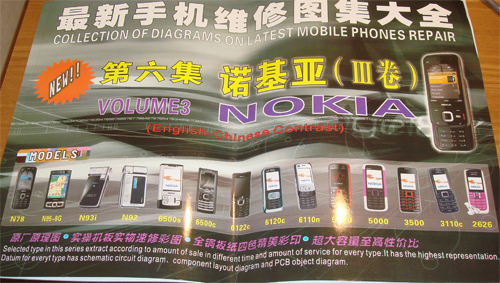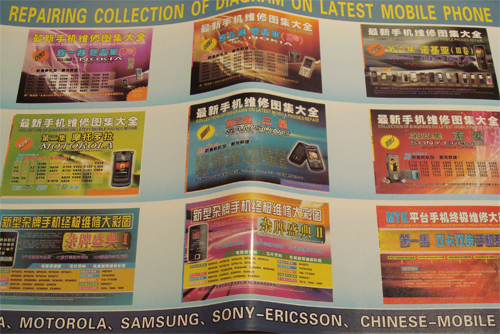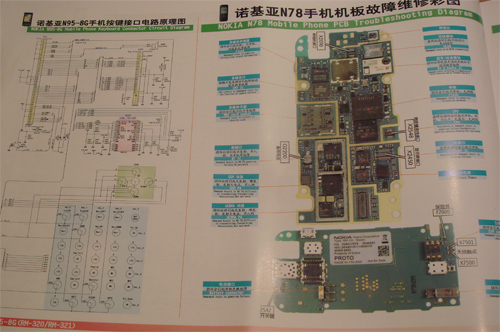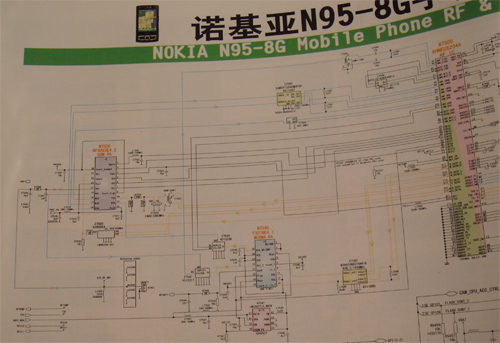I was wandering around on a rainy Saturday afternoon in the mobile phone market in Shenzhen and I spied a stall keeper working on a phone motherboard. Unlike most of the other folks in the market, he was working from a set of schematics — that got my attention. I asked him where he got his schematics from and he kindly dispatched his young son to walk me over to the small tool shop on the other side of the market where, buried underneath a pile of single-use BGA SMT stencils, was a collection of mobile phone schematics for just about every phone made.
I don’t know about you, but getting my hands on schematics gets me really excited. This is like, the Ultimate Hardware Geek Pr0n. Sure, undressing a mobile phone and revealing its tender innards to my gaze — the sweet perfume of flux residue unleashed, curling into my nostrils — is one level of hardware voyeurism. But, getting the schematics for the phone and peering into its very circuit diagrams — that’s a whole new level, like tearing off the undergarments and ravaging the bosom of the phone. I was excited. I brought the manuals to the clerk and asked how much…wincing at the price I may have to pay to bring these prized morsels back to my hotel room. I breathed a sigh of relief when he asked for only 75 quai — a little over $10 US — for the whole three-book collection. I didn’t even haggle. I grabbed my booty and ran for the nearest taxi.
Alright. Don’t take my double entendre too literally; it’s just fun to write that way. Anyways, on to the manuals…

As you can see, these are sold as service manuals.

A sample index entry.
Each phone has a scan of the circuit board that is annotated to call out the position and function of all the components. This helps with the repair process.
A detail of the schematic for the Nokia N95’s RF section.

The same publisher of these schematics also offers a wide library of schematics, including those for Samsung, Sony Ericsson, Motorola, and Chinese-local “copycat” phones (like the iPhone clone in the lower left hand corner).
It’s hard to say if these manuals are legitimate (in the sense that Nokia deliberately released the schematics for use as a repair guide), or if they were stolen and republished as a “repair guide”. I doubt, however, that they were reverse-engineered out of the phone, because the schematics contain references to codenames and lingo that would not be embedded directly in the circuitboard. A bit of searching around on Google reveals that these manuals are available for downloads in bits and pieces on various websites, but they all seem to derive from a Chinese origin, and not from Nokia directly.
When I give talks about Open Hardware, I emphasize that it’s fundamentally impossible to keep hardware closed, because the source is the same as the product. Schematics can be derived out of a circuit board layout — a completely legitimate activity under US law. There are shops in China that will pull out a netlist in a couple days for under $1k, and services in the US that will take a bit longer and cost you a lot more. Significantly, there is a whole lot more that goes into building hardware than a mere schematic design: it takes me days to capture a schematic, but it takes me months to get it into mass production. Thus, I believe that publishing a schematic makes the product more serviceable and more useful, yet has little negative effect on your competitiveness in the marketplace. This is a key difference between software and hardware, as the time between writing software and publishing it to “production” can be as short as a few seconds for web-based services.
From my personal perspective, having the schematics is handy for a number of purposes. Aside from satisfying a general curiosity about the phone’s structure, it’s interesting to see the details on how certain sub-circuits are implemented. For example, when I learned electronics at MIT, they never directly taught me how to do EMI mitigation, or ESD protection. While I know the theory behind it, the implementation is trade-craft know how; these are subjects where experience trumps knowledge. Therefore, seeing Nokia’s take on it expands my understanding of the subject.
The schematics are also very useful because of Nokia’s buying power. Picking the cheapest part for a mass-produced hardware design is a tricky exercise; when you leave the realm of buying a few hundred or thousand pieces at a time and move into really high volumes, often times the price of the part has less to do with its design features and more to do with its physical dimensions and who is buying a lot of it. If someone like Nokia is buying millions of a certain part a year, the supply of this part is very stable, lead times are shorter (usually), and the price goes down. So, if you’re a small company and you want to build something cheap, you want to pick parts out of the Nokia supply chain because you indirectly enjoy the benefits of Nokia’s buying power. Thus, these schematics are a good starting point for sourcing cheap parts for production.
Update: got the books for Sony-Ericsson, Motorola, and MediaTek-chipset phones. Found only one Samsung book and it was very out of date. From my observations, the books left on display in these small shops are remainders — typically a little older, perhaps a little less popular. I had to scour the market to find a few of the more recent books, which probably means they are out there but I just don’t know the right person yet. Interestingly, the MediaTek-chipset series of books included some “how-to” manuals on using the chipset to build your own phone. This may be part of the “open” repository of hardware knowledge I previously mentioned in my post about the Shanzhai phone-copiers-turned-innovators.


The PCB scan has a label on the lower board that indicates the phone is a prototype model, saying “Property of Nokia,” “PROTO,” and “Not for sale,” which suggests that they somehow originated at Nokia. Of course, whether or not they were stolen, repurposed, or released officially is still unknown.
I also noticed that the schematics use European symbol and naming conventions — not that it means a lot, many of the Chinese engineers out here have European training, but locally drawn schematics rarely follow such strict and uniform conventions across volumes of schematics.
The depicted circuit diagram do not comply with european standard.
For example, the coils/inductivities are marked using half-circles, which is/was a German convention. European convention (and what they teach in universities in Germany nowadays too) is to use a filled rectangle.
oh by the way: The colors!
Interesting, I didn’t know about the European inductor convention. The European engineers I’ve worked with use the “box resistor” and bar ground symbol, along with the 4u7 versus 4.7uF notation for component values. It’s made for some humorous white board discussions. I’ve never noticed a difference in their convention for inductors…maybe they had been in America for too long!
If there’s schematics of a Sony Ericsson product in there, could you post a picture of it?
I work with their products and know exactly how their originals look like. I’m simply curious if it’s the original schematic, or if they RE:d it.
You’re in luck. I went back to the market and got a book of Sony Ericsson schematics (and a few others). Here’s a shot from one page:
http://bunniestudios.com/blog/images/sony_w810.jpg
Let me know what you think! The style used in each book varies by manufacturer; the Motorola book, for example, uses American schematic conventions. Also picked up some books that teach you how to design your own mobile phone schematic. Maybe I’ll try my hand at building one someday…
Although similar, the schematics are different in style.
They are a bit too impressive to be completely RE:d, so they might have giving the originals a make-over to fit their own style..
Reminds me of the Sams Photofacts that were available in US for all sorts of electronic equipment back in the good old days.
Great blog, and we really like our Chumby too!
I agree you could get a schematic of most anything with Sam’s Photofact. Now days the companies will not release schematics to the public. Probably when the Chinese started to reverse engineer everything under the sun companies stopped. We must make them ourselves. This is a good skill to have.
Are you aware of any place that would export these schematic books? I’d love to have a set.
I came accross on the web: http://www.ipmart.com/main/product.php?prod=25856
-anthony
I’d give my left nut for an iPhone 3GS edition of this ‘aftermarket’ manual.
Just saying, is all.
I know they like to barter, but I’m not sure they’d take that in trade.
Sure they would. What do you think happened to my right one? That’s how I got this nifty iPhone 4G prototype.
I hate retards like these.
The iphone 3g is called ‘3G’ because the network it uses is the ‘3g’ network. The first iphone, used the ‘EDGE’ network, and is therefore called the iphone ‘EDGE’, not 2g not 1g… the next iphone will not be called 4G, as there is no telephone network with the corporate name of ‘4G’ . Please, I ask all the retards to STFU, how do retards even make it to this blog is beyond me.
Do some research before flaming lest you make yourself look like an idiot: http://lmgtfy.com/?q=4g+network
facial
[…] A soon to be classic post by Bunnie I was wandering around on a rainy Saturday afternoon in the mobile phone market in Shenzhen and I spied a stall keeper working on a phone motherboard. Unlike most of the other folks in the market, he was working from a set of schematics — that got my attention. I asked him where he got his schematics from and he kindly dispatched his young son to walk me over to the small tool shop on the other side of the market where, buried underneath a pile of single-use BGA SMT stencils, was a collection of mobile phone schematics for just about every phone made. […]
I’d love to get my hands on the manuals for the SE w850i and Nokia 7650, I killed mine way back and would jump at the chance to take a guided tour of their insides.
The Nokia schematic looks quite similar in style to what we used at the official dutch Nokia Repair centre. Although this one gives many more repair hints directly at the board photo (but that may be a new way Nokia does things, I havent worked there for a few years).
You know what would be great, is a PDF so we can really see the detail.
Is there any chance that the W42S or W52S or similar phones might be in that Sony Ericson manual?!?!
I run a blog site for foreigners using the two phones. I suppose the next closest cousin would be any ‘Walkman’ branded Sony phone.
Hi, Great post. Would love to chat with you some time. I visit these markets regularly too, and have a stack of those schematics books on my desk. I’m a wireless industry analyst, and would love to get your take on the market.
Do you have shematics for the n800?
On web there only low resolution ones… (cant read text)
Hey bunnie, here’s an idea. Digitize the PDFs, and publish them online for free. People can print them if they want. Maybe even in monochrome. Open a store with some printer company and offer awesomely done copies for like $15 a manual.
Or do neither.
I agree with $I above. Would you consider posting pdf’s or jpgs of the repair manuals?
It makes sense that 3rd parties be given the schematics because much/most electronic devices are manufactured in China, Taiwan, etc, so to manufacture, the schematics are required. And since the schematics can be obtained from tracing and/or viewing, they aren’t exactly trade secret, thus can be ‘freely’ published.
You have all the manuals at http://www.warez-bb.org you should search for service manual nokia
[…] Check out other articles on the site schematics of Nokia phones Mobile Phone Megamarket in Shenzhen Hacking the PIC 18F1320 Awesome stuff!! […]
there are some available in pdf format at http://eserviceinfo.com these are usually available to authorized service centers in both pdf and printed format. In different levels depending on the stages of fault finding.
You should totally scan and torrent these manuals. :p
[…] 11:15 am on August 8, 2009 Link Permanente | Responder Interessante o post do Bunnie’s blog mostrando um material que ele comprou em Shanzhai (China), supostamente com esquemáticos e […]
[…] Nokia Schematics!, the owner of this blog found a book at the Shenzhen mobile phone market which contains schematics for numerous well known mobile phones. […]
Hi to everybody…
take a look here for mobile schematics
http://www.shrak-mobile.com/eng/index.html
Hello I want to inquire about how to obtain these schemes you are free to buy or how to purchase and possible
Hi,..
I involved in ductless fume hoods industries. Now, ductless fume hoods also have manufactured in China. I just concerned on the quality and safety issue. See what had happened to Nokia products..
Nokia is the most popular mobile phone here in china.
Hi,
There are thousands of SERVICE MANUALS available FREE of charge on ElektroTanya site!
Check it!
http://elektrotanya.com
[…] while ago, I stumbled about this great post from bunnie talking about some Nokia Schematics he found on a market in Shenzhen. Since almost everybody would consider a broken mobile as […]
Hello there.. very nice and useful writing, I think you really know about this problem. thanks for your posting about this, it help me a lot.
did u can help us to get tech circuit diagrams down load on line a the reasonable rates
I had an Nokia N82 which had lasted me some time and was beating away all pretenders to the throne. It had proved a very capable phone with its highly regarded camera and the stability of S60 3rd Edition. That said I had wanted a change for a good while, only nothing that came along was managing to get my pulse racing. I had been thinking the iPhone 3GS was next on my list but, to be sure I liked an all touch screen device, I decided to test the water with a Nokia 5800.
My Nokia N95 mobile’s external jack is not working (I replaced my jack).
pls i need nokia schnematics pls just show me good link and i willbe greatful THANK THERE IS MY EMAIL ADDRESS godfrey.oboh33@gmail.com
Even though the coming of updates of nokia cellphones, I will still stick to 3310. It has a good quality and very durable. Camera’s and Radio are not my priority now just want the call and text so I will use the said unit.
Hi all….please…some body can tell me where i can buy a schematic repair in the pictures up?
Thanks a lot